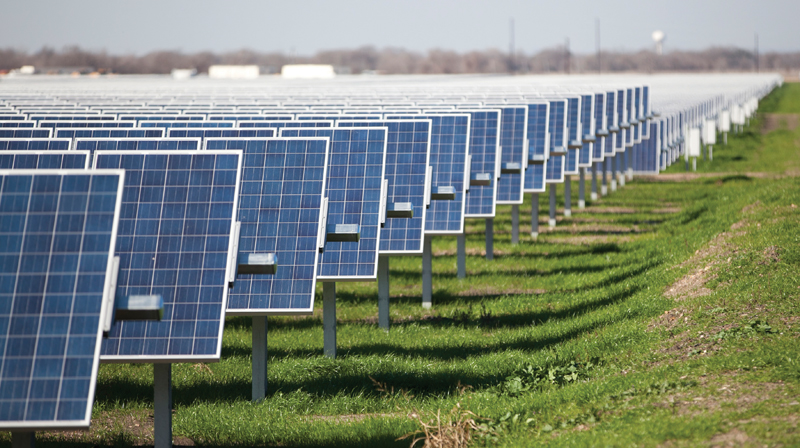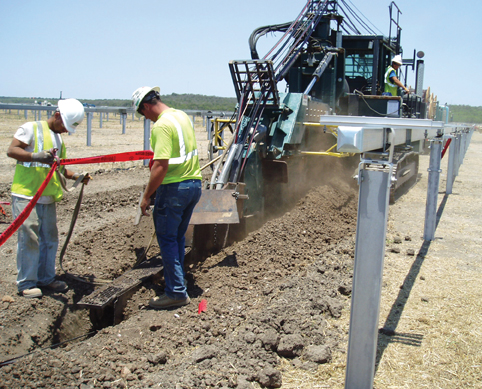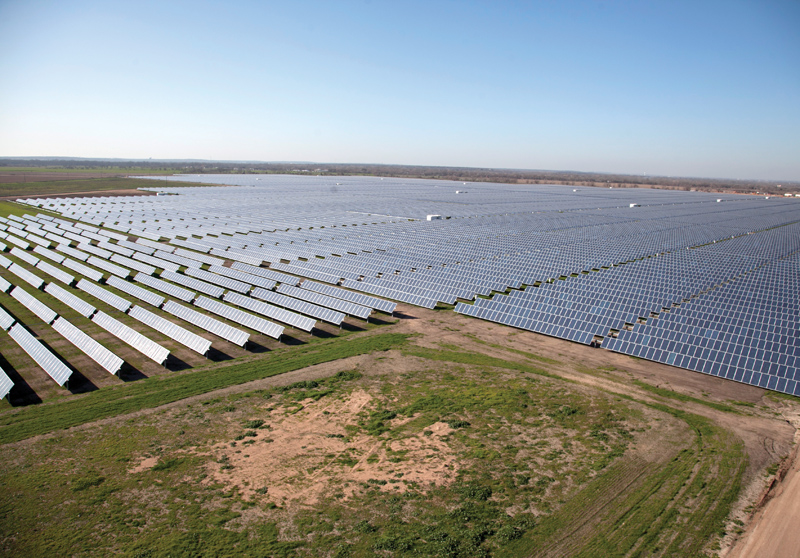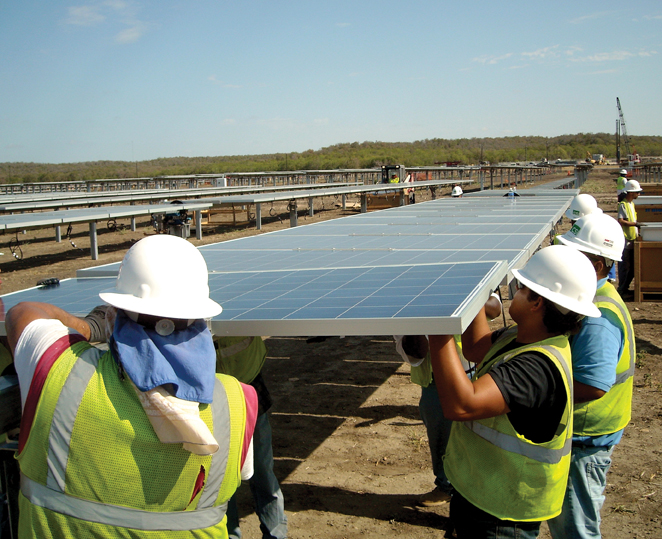Back Issues
Webberville solar project in Texas means megawattsTexas is known for thinking big, and the Webberville solar project near Austin is no exception—at 30 MW, it is the largest solar project in the entire state. By
Paul MacDonald
Austin Energy has developed one of the leading renewable energy programs in the U.S. It owns the country's first and largest green building program, and the city is home to one of the nation's most comprehensive residential and commercial energy efficiency programs. Austin City Council recently set up a Solar Committee to review further ways the city can pursue solar power, whether it is through encouraging residential installation or large scale solar projects. The Austin Energy Resource &Climate Protection Plan approved by the Austin City Council in 2010 set a target of achieving 35 percent renewable resources by 2020. This includes 200 megawatts of solar capacity and 1,000 megawatts of wind power. During fiscal year 2011, about 10 percent of the power delivered from Austin Energy to its customers came from renewable resources. Austin Energy will be purchasing all power generated from a 100-megawatt biomass plant scheduled to go online in June 2012. In September 2011, the Austin City Council approved two new 25-year wind contracts, which will bring Austin Energy's total wind output to more than 700 megawatts by 2013. This will bring Austin Energy's renewable energy portfolio to around 25 percent. But the latest move to alternative energy for the city came earlier this year, with the start-up of the $250 million, 30 MW Webberville Solar project, the largest solar power project in Texas. Under a Power Purchase Agreement, Austin Energy has agreed to purchase the electricity generated by the project for 25 years. The Webberville project, which is 15 miles east of the city on land owned by Austin Energy, was developed and financed by FotowatioRenewable Ventures, a division of Spanish renewable energy companyFotowatio SL. It was owned by SunEdison, which sold it to MetLife and Longsol Holdings in late 2011. Longsol Holdings is a private owner and operator of solar projects in the U.S. and Europe. RES Americas built the Webberville solar facility and will provide maintenance services for five years. Anna Giovinetto, vice-president of corporate affairs for Colorado-based RES Americas, said its expertise in development, engineering, and construction allows it to offer solar clients the same suite of innovative solutions, in-house engineering, and construction performance capabilities that it delivers to the wind industry. "I think there were good reasons why we were selected as the Balance of Systems contractor for Webberville," said Giovinetto. "I think our extensive experience and great track record in wind power indicated to the client that we had the in-house capabilities to successfully meet or exceed their expectations on the Webberville solar project." Austin Energy issued a request for proposals in 2008 for the Webberville project. RES Americas became involved in the fall of 2010, with limited notice to proceed in December 2010. Engineering, procurement, and logistics planning began immediately—RES Americas moved quickly to take the work that was done in the development stage, optimize the design, and turn it into a construction-ready package to meet the contract schedule. The project began construction in spring 2011 and was completed this past February.
RES Americas has all of the required design/build capabilities in-house, with a development team that the company says can manage all development activities for these projects. Having both the engineering and construction teams together under the same roof makes the process more efficient and cost-effective for clients, while simultaneously ensuring high quality results. Its capabilities include engineering design, resource analysis, and modeling expertise; close coordination between field staff and engineering; rigorous internal procedures for safety, environmental, quality control; and a proven history of success, including close relationships with utilities, power authorities, local government, and landowners. "Among the strengths we have are these terrific in-house engineering and construction teams, folks who are experts in their field," said Giovinetto. "They have been working together for a long time, and they work in close coordination. This is advantageous for our clients because it enables seamless communications between those teams, and things happen a lot faster. It's a more efficient process, and it makes projects more cost-effective, whether they're big wind farms or big solar facilities." Big is the perfect description of the Webberville solar project. The solar field covers approximately 220 acres, and the project has 127,728 Trina Solar modules. Eighteen large module sections are connected together in a series and are wired to 448 combiner boxes that are distributed throughout the site. A total of 26,400 driven piles were installed to support the 2,400 rows of single axis trackers. There are 112 tracker motors that move the modules to follow the sun from east to west. Nineteen centralized inverter houses/step-up transformers convert the 35 MW of DC power to 30 MW of AC power. Linking the project to the grid required significant upfront coordination with the Electric Reliability Council of Texas (ERCOT) and Austin Energy, considering this is the first project of its size in Texas. Each year, the plant is expected to produce approximately 63,000 megawatt hours, which is enough energy to power 5,000 average homes. The solar module layout was based on pre-installation engineering analysis and proved effective to meet performance requirements, says RES Americas. Some adjustments for site-specific elevation considerations due to flood-plain were required. The project uses a combination of Trina Solar 270, 275, and 280 watt poly crystalline solar modules. The modules are mounted to Array Technologies Duratrack HZ horizontal single axis trackers with central motors and drivelines connecting up to 22 rows (1,188 modules).
There was a large volume of electrical components and connections requiring testing/commissioning. To keep things moving forward on the ground, RES Americas practiced cross-functional teaming of seasoned engineering, construction, and procurement personnel who applied best practices. Staff used a disciplined approach to manage field construction techniques and quality control/assurance by using upfront reviews of critical characteristics and consistent follow-up. Additionally, there is a daily team review of project schedule and milestones. Big projects are, as Giovinetto put it, in the company's DNA. Its parent company, Renewable Energy Systems Ltd, was originally formed as part of the Sir Robert McAlpine group, a British family-owned firm with over 145 years of experience in the construction and engineering sector, and which recently completed construction of the 80,000-seat Olympic Stadium for the London 2012 Olympics. UK-based Renewable Energy Systems Ltd. has been an established presence in the wind energy industry for over two decades, developing, designing, building, and operating wind farm projects worldwide. It has a portfolio of more than six GW constructed and several thousand megawatts under construction and in development. In particular, Giovinetto says there were several keys to the Webberville project being successful, among them coordination and communication. "Because our engineering and construction teams are in-house, with their offices right next to each other, they are used to coordinating with each other. It's not a situation where you have two different firms that are passing things back and forth. "We also emphasize communications, both within our company, and with our clients and external stakeholders, which in the case of Webberville included the City of Austin, ERCOT, and Travis County. We really see transparency and communication as being critical to a project's success." The project owner had precoordinated most permits. But regular meetings were held with local authorities at pre-construction and during construction to provide regular progress updates and ensure compliance with local regulations including environmental, fire, building, and highway. The aggressive construction schedule (nine months to fully construct the 30 MW project) required daily monitoring of progress of material deliveries and installation. For example, the daily number of piles driven and daily number of modules installed was monitored closely. Day and night shifts were used at critical points to maintain production. With construction of the Webberville project now complete, Giovinetto says RES Americas expects to remain active in solar construction. "We see solar as an exciting growth market both in the U.S. and Canada, and part of our strength as a company is derived from our ability to diversify and pursue other markets, both in terms of different technologies as well as geographically."
|












